Explore The Magical World of Coffee
Scene from: Graveyard of the Percolators, Universal, 1937
(l. to. r.: Johnny Weismuller, Maureen O'Sullivan, Joseph P. Lash, DeWitt Dagstahl)
There are exciting things inside your kitchen...
Let's Take a Trip Inside Your Coffee-maker!
If you drank as much coffee as I do, you'd begin to appreciate my fascination with all things having to do with the Noble Bean. This page is all about the mechanics of brewing coffee, particularly those very bizarre and complicated Vacuum Systems that were all the rage in the 1930s.

Join Us on Facebook
I will repeat my oft-stated thesis that the most important factor in brewing coffee is the temperature of the water. All the rest is minor -- if you have water at 202 degrees Fahrenheit, you will get a wonderful cup of coffee with even the most inexpensive ingredients. If the temperature exceeds 202 degrees, there is no exotic ingredient or blend that will make a tasty brew. Next on the list is pure, distilled water, and next is scrupiously clean equipment. After that, you can start talking about blends and technology. For my money, the best coffee technology that you can buy is a Melita drip system with lab-quality paper filters (You will, of course, also need a good kettle and a laboratory thermometer.)
Note that back in 1941, the A&P markets -- now "Fresh Fields" -- were very aware of all the possibilities for coffee brewing. At that time the "Regular Pot" meant "boiled coffee".
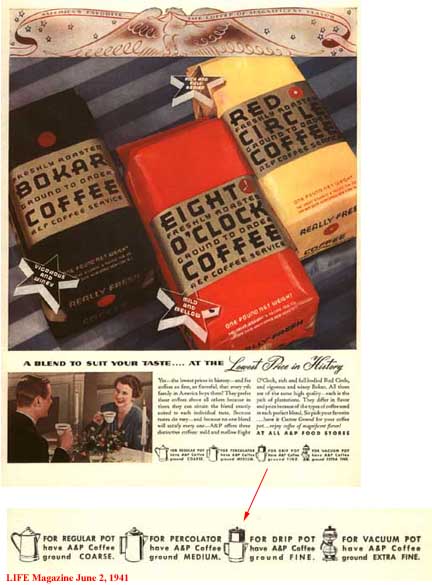
Ad from the A&P Markets Showing Coffee Technology in 1941
I Still Like BOKAR Better Than Any "Fancy" Coffee
These Are Some of the Best Packages Ever Designed
The Eagle is saying "America's favorite...The Coffee of Magnificent Flavor"
That said, let's investigate some of the complex schemes that have been used to brew coffee.
As I have hinted, the correct method of brewing is labor intensive: you have to heat the water to the proper temperature and infuse it with the ground beans. The brew must be collected into a server for delivery to the ultimate consumer. So, the three major factors in coffee technology are heating, infusion and serving. All of the technology centers around "labor" from each function.
- Boiled Coffee
- The Percolator
- Drip Method
- Vacuum Method
- The Vesuviuo
- Espresso
- Replacement Cords for Appliances
In the Beginning
The simplest possible way to brew coffee is to boil it. All you do is put the ground beans into a pot with water, put heat underneath it and let the water boil. After you turn the heat off, you are left with a sludgy mixture of grounds and coffee that has to be strained. If you use a sauce pan, you can strain the grounds using cheesecloth. The typical "coffee pot" has a strainer built into the pour spout. Note that heating, infusion and serving are integrated in one place.
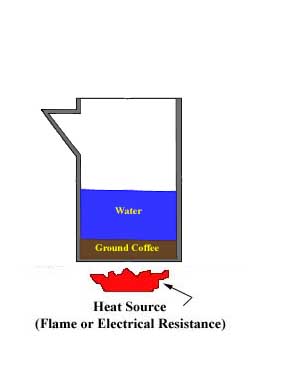
Generic Apparatus for Boiling Coffee
Over time, a wide variety of shapes were tried to permit the coffee to be heated but also to facillitate decanting the brew. Tinsmiths fabricated a large number of fanciful shapes but they have two things in common: (1) a broad bottom seems to be favored to allow maximal contact between the water and the heat; and (2)a tapered neck to suit the decanting function. Although Dr. Samuel Johnson was an apsotle of tea in the Golden Age of Coffee-Houses, his literary foil Joseph Addison would have most likely favored coffee brewed with a "biggin" -- the grounds were placed in a cloth bag and then boiled. (In Edward Bramah's treatise on coffee-makers he says that a wool sock was most effective, although he does not indicate whether it was a new or a used sock.)
The economics of mass production eliminated the fanciful shapes and eventually led to the truncated cone shape that is easily recognized as a "coffee pot" the world over.
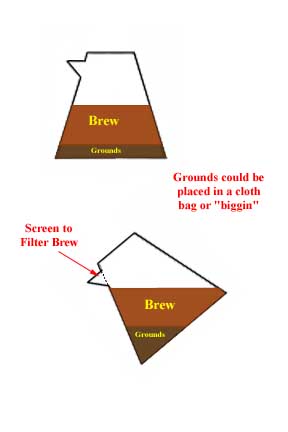
Removing the Grounds has Influenced the Shape of the Coffee Pot
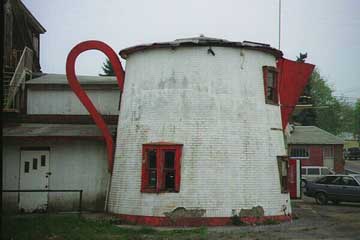
The Coffee Pot
Instantly Recognizable from Miles Away
Boiling Coffee is most often associated with Cowboys on the Trail. When I was at the Marlboro Party Ranch, some of the "old ranch-hands" allowed me to use a historic trail pot to brew coffee. Shown below, it is made of spatterware and uses about a pound of coffee to make a full pot.
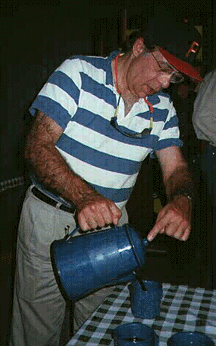
Cowboy Style Coffee
After you have been riding for a whole day, this stuff doesn't taste too bad. But, there are two tricks: (1) you have to watch the pot very carefully to take it off the fire as soon as the water starts to boil and (2) you should toss a few eggshells into the grounds. The former is to minimize the effects of the temperature exceeding 202 degrees. The eggshells have a very thin membrane that helps congeal or "clear" the grounds and makes them easier to strain.
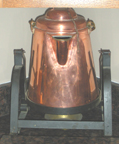
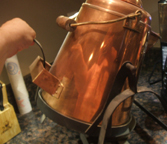
Copper Kettle for Making and Serving Boiled Coffee
Click to Enlarge
Here are photos a copper coffee boiler/server that were sent to us by our reader Lori. This elevates boiled coffee to a high plane!
We got this note about boiled coffee from Tony Nesky:
"...I like boiled coffee the best. However, I don't associate boiled coffee with camping---I associate it with Poland. Coffee was traditionally served in glasses. A tablespoon of coffee was stirred into water that is just slightly cooler than boiling. The mixture is then allowed to brew a few minutes, then vigorously stirred. It's ready to drink when the grounds have settled to the bottom of the glass. It's a matter of taste how far down to the grounds one drinks the brew. I once took my 'podwieczorek'--afternoon coffee and cake--in a nice cafe in Warsaw. The brew was served in a china coffee cup which was somewhere in size between a teacup and a demitasse. The coffee had a heavy consistency, having been prepared by boiling a fine grind, and its thickness was augmented by a generous portion of real cream. A cup of this coffee and one of the fine pastries was enough to keep me walking and sightseeing before a late dinner.
Poland experienced an incredible economic boom after the fall of communism in the early 1990s, a boom which resulted in part from a 50-year old pent-up demand for household goods. There was a particular mania for the 'ekspres do kawy'--the drip coffeemaker. When I ordered coffee in a restaurant, I always had to ask whether 'kawa ekspresowa' meant coffee from a drip coffeemaker or the Italian-style expresso. One couldn't get boiled coffee--apparently restauranteurs thought it was declasse.
Not to worry, though--the free market matches supply with demand. On a recent trip to one of the Polish supermarkets in Chicago, I bought some Polish 'Cafe Primo,' a strong blend with a grind 'suitable for boiling.'
You can also get a very good cup of coffee if you are lucky enough to attend a function at the Polish Embassy in Washington. The Embassy would serve coffee from a thermal carafe in demitasses. The brew was perfect--strong, but not bitter. Guests raved about it, and one managed to collar the Embasy chef and find out his secret. He boiled the coffee in quantity and filtered it. ..."
Not only did Tony write about it, but he presented me with a wonderful 250g package of Cafe Prima:
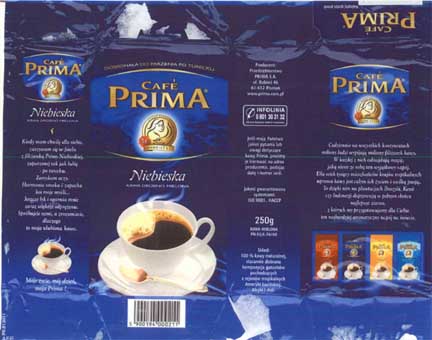
The Cafe Prima wrapper (Niebieska= "Blue")
"Kawa drobno mielona" means "Coffee, Fine Grind"
Thanks to the Online Polish-English Translator, I was able to gain some insights into Polish techniques for writing advertising copy. You might be interested in it:

Only the Best for You
English: "On all continents, millions of cups of coffee are consumed daily, and this exceptional drink brings magical pleasure to all. For hundreds of thousands of people in tropical countries, coffee is not only a way of life but also a passion. From the plantations of Brazil, Kenya and Indonesia we use beans ripened in the full sun to make this aromatic brew just for you."

Coffee for those "Special Times"
English: " In a peaceful moment, I like to curl up in my armchair with a cup of Cafe Prima (Blue) because I like my coffee strong - Turkish Style. I close my eyes and each sip brings relaxation. Try it yourself and you will know why it is my favorite coffee."
They did not have "NEW", "FREE", or "IMPROVED", but advertising seems to be the same the world over...
Tony was right -- this is wonderful stuff for making boiled (Turkish-style) coffee!
Our reader Candy Eve from California also has this comment on boiled coffee:
"... I am allergic to yeast and found that by boiling the coffee as with a percolator, it kills the yeast, and I can drink all I want! So in spite of hearing at WILLIAM SONOMA last Sunday that "Coffee should never be boiled..." ..."
This adds a new dimension to questions about boiling coffee.
Percolation
Soldiers and Cowboys suffered for many years before before an enterprising Illinois farmer named Hanson Goodrich invented the Percolator. His patent was granted on August 16, 1889 claiming " an attachment that can be arranged in any coffee-pot; it is a slightly covex circular or supporting, or base plate, with a tube rising therefrom, and a cup, secured to the upper end of the tube. It is so constructed, so that placed within the coffee-pot, the water, when it becomes heated, rises in the tube, escapes into the cup, in which the coffee has been placed, and 'percolates' through the same, as to extract the strength therefrom, finally escaping through the perforated bottom of the cup, to the water below, producing a liquid which will be free of all grounds and impurities so that it is not necessary to use any clearing materials".
Hanson Goodrich, Father of the Percolator
The percolator represents an improvement over boiled coffee because it removes the need to strain the brew; however, as shown below, infused coffee drips down from the percolator basket and mixes with the water to be boiled. Alas, this virtually assures that the temperature of the coffee will exceed 202 degrees. It is virtually impossible to make a decent cup of coffee with a percolator. As discussed above, I would actually prefer to boil coffee rather than use a percolator.
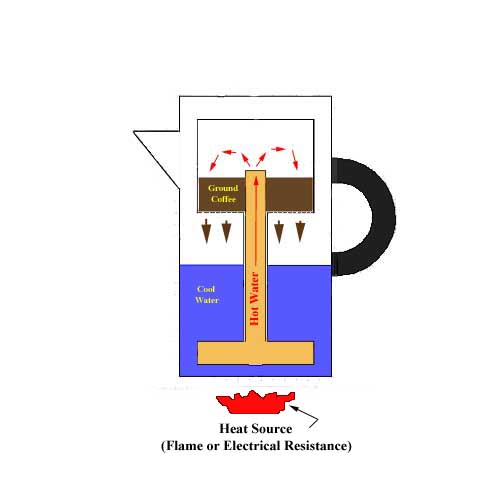
Generic Apparatus for Brewing Coffee by Percolation
However, you will note that the percolator combines heating, infusion and service in the same vessel. You can still buy percolators today. Some people even have a taste for coffee made with this device. I do not...
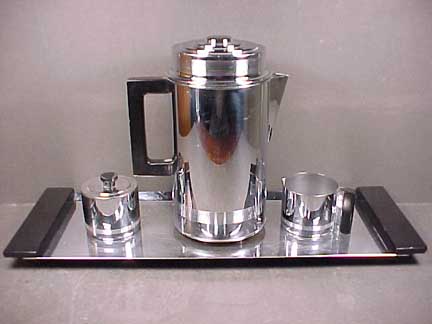
Manning-Bowman "Geniality" Percolator Set
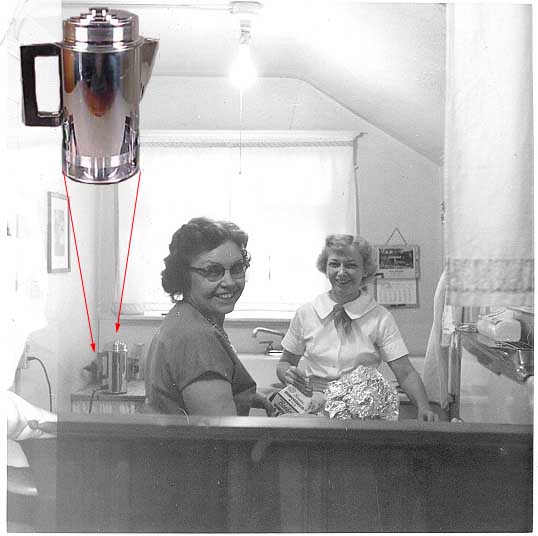
The "Geniality" Percolator in situ, c. 1958
One of our readers sent ust this photo of a very elegant manning-Bowman percolator and its associated cofffee service. The catalogue number was "382/6" and the stule was called "Geniality" -- based on the serial number (5/35) we infer that this particular percolator was manufactured in May of 1935. Indeed, the photo taken in the kitchen of Ron's mother shows the percolator in use in the 1950s.
Drip Brewing Systems
Advances in Chemistry and Culinary Science led to a more fundamental understanding of coffee chemistry and the dynamics of brewing. It became clear that the infused brew could not be over-heated without producing very distasteful organic acids. Laboratory techniques for infusion were adapted to home use. The process is quite simple. As shown below, the grounds are placed in a receptacle (the "Drip Basket") that is lined with a filter. Hot water (at the appropriate 202 degree temperature) is poured into the filter chamber and the infused brew drains into the server. Nothing could be simpler.

Schematic of the Drip Brewing Method
There are a number of variants on the Drip system. For example, the Chemex system shown below uses a paper filter. The Chemex system is a symphony of design mixing glass wood and leather; it is on display at the Museum of Modern Art as an example of outstanding product design.
The Chemex System for Drip Brewing
A variety of drip-brewing utensils are available with porous metal filters. Here is a 32 cup drip coffee-maker that uses a whole pound of coffee at a time. The top portion holds the metal filter and is removed before serving the brew.
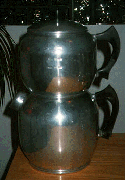
West Bend "Kwik-Drip" Coffee Maker
Most contemporary coffee brewers use the drip system and include a mechanism for heating the precise amount of water needed and delivering it to the Drip Basket. This type of brewer began in the 1970s with the emergence of the "Mr. Coffee" brand, as promoted by baseball great Joe Dimaggio. Of all things, one of oour readers sent us in these photos of a very early manual version of the "Mr. Coffee" system. This is just the drip basket and the server, decorated with those everpresent (and obnoxious) flowers-that-look-like-asterisks from the 70s.
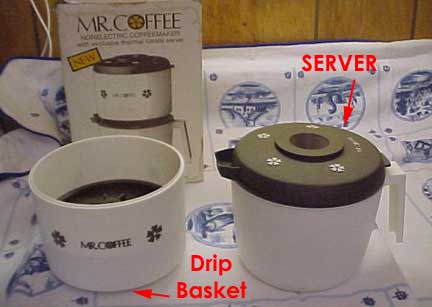
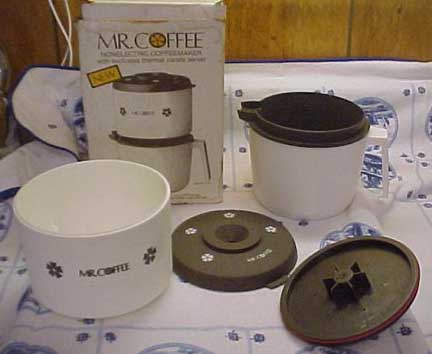
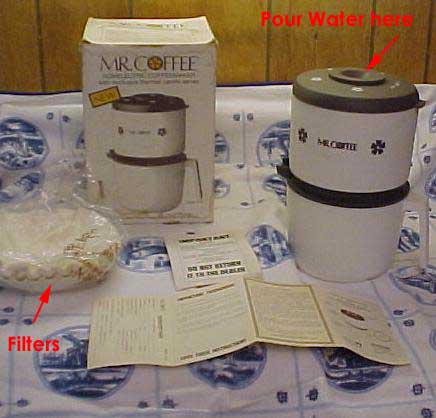
The Manual "Mr. Coffee" Drip Brewer
Thanks a whole bunch to our reader Martha!!
The French have developed a very clever variant called a filter press or Cafetiere a` Piston, as shown below:
The French Filter Press
Operation of this device is very simple:
- Remove the lid and filter assembly.
- Measure coffee grounds into the coffeemaker.
- Pour in very hot water .
- Replace the lid and filter assembly, keeping the filter at the top.
- Let coffee and water steep together for 2 to 5 minutes, depending on desired strength; the longer they steep, the stronger the coffee.
- slowly push the plunger down, to filter the coffee. Doing this slowly will keep most of the grounds under the filter of the plunger.
- Pour the filtered coffee, sit back, and enjoy
Click Here for a much more detailed history of French Filter Press coffee brewing.
There have been a number of attempts to create a "one-cup" drip brewing system that might appeal to singles or people who don't drink a lot of coffee.
Here is a very early Silex one-cup drip brewer. It used a paper filter weighted down by a glass "knob" or "sprocket" to catch the grounds, hence its "technical term", the grounds-holder). [Thanks very much to our friend Karen for these photos] It is made with the "ribs" that indicate early models, because the technology for forming clear, smooth Pyrex that was break-resistant had not yet evolved.
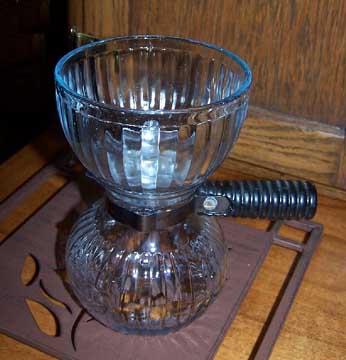
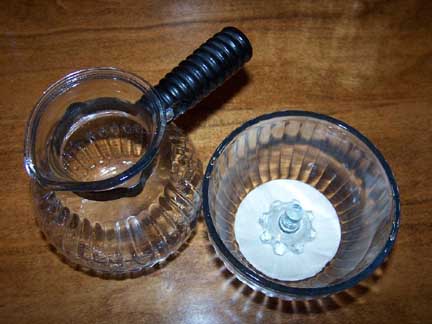


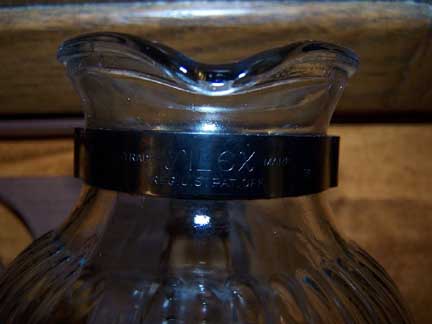
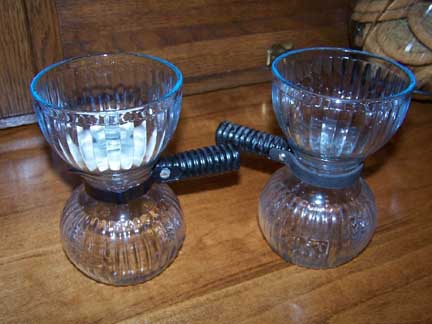
The Early Silex One-Cup Drip Brewer
Another of the earliest of these is the "kwik-cup" brewer marketed by the Hartford products Corporation of Chicago, Illinois. Our friend Kim found one of these unused in the original; box in her grandmother's house.
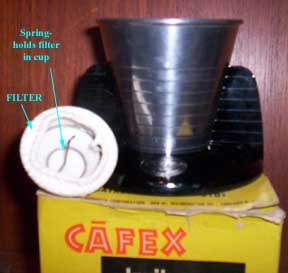
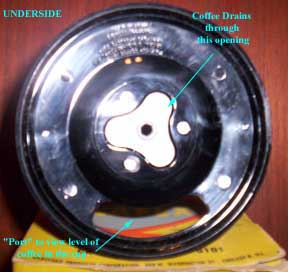
The CAFEX One-Cup Drip Coffee Brewer
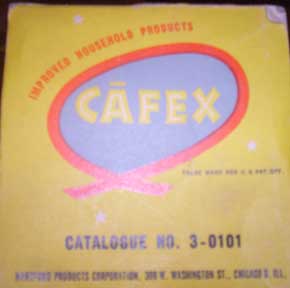
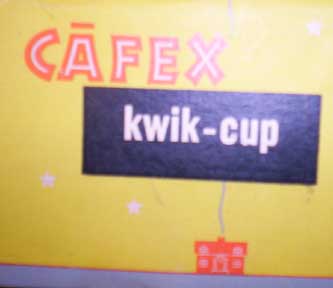
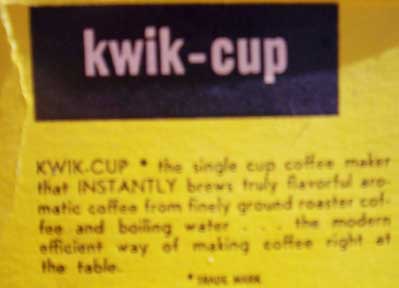
The CAFEX Original Box
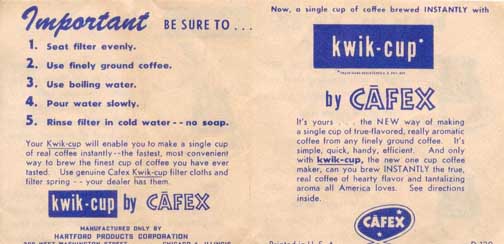
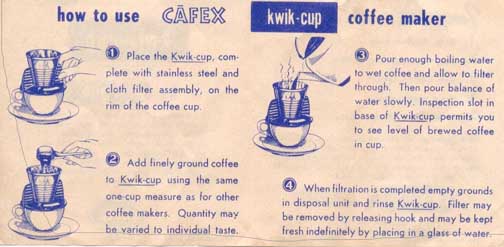
Directions for Using the CAFEX One-Cup Drip Coffee Brewer
I have been through the trademark and patent applications, and I don't think that the "Hartford Products Corporation" ever bothered to apply for a patent or trademark for this thing. My guess is that they threw this together as a "Kwik-Gift" for the Christmas Holiday Season and sold them as stocking stuffers or "arms-length" gifts.
I have looked at this up,down and sideways, and it looks like you might be able to brew one cup of coffee with it and then the mess of washing the filter would keep you from ever using it again. PLUS, I don't think that the shape of this brewer is very efficient.
"One-Cup" brewers have not had a high rate of success, because the kind of people who might be tempted to brew one cup at a time usually want to drink a lot more coffee than one cup. I will be willing to bet that ALL the "kwik-cup" brewers that are out there are unused in their original box!
This is, indeed an interesting historical dead end in the world of Drip Brewing Systems. If you really only want to make one cup of coffeee, Melita makes a one-cup brewer, but sells little disposable paper filters for it. Folgers makes a kind of "coffee-bag" version of this in their "Coffee Singles" packages. Of note, they are about the only firm offering this -- the things don't sell well enough for the supermarket chains to offer their own competing "House Brands."
As I said, the drip method is my favorite way of making coffee. The techniques shown above require an external source of heated water (i.e. from a kettle...) In the 1980s, the Mr. Coffee appliance was developed to integrate heating with infusion and serving. In that case, a reservoir of water was heated with electrical resistance coils until the proper temperature was reached. Then, the water was discharged into the filter. These devices are quite convenient but it is virtually impossible to clean the tubing through which the hot water is discharged; eventually, calcium sediments will build up and add a bitter taste to the brew. These devices are only good for about six months unless you exclusively use distilled water.
The Vacuum Brewer
The high point of coffee gadgetry came in the 1920s with the introduction of the Silex "Vacuum Coffee Service Set". It should be noted that there are historical devices using the vacuum principle that were made in England and France during the 1800s. These are quite rare and were not "mass market" items. In many cases, they were quite dangerous. The Silex machines are among the very first to be offered to the genral public and to be manufactured in great quantity. Heat resistant Pyrex glass had just been perfected and it was used to great advantage in that did not reheat the coffee once it had been infused. The essence of the vacuum method is that steam is used to BOTH brew the coffee AND keep it out of the water heater. This is a VERY tricky process as shown below:
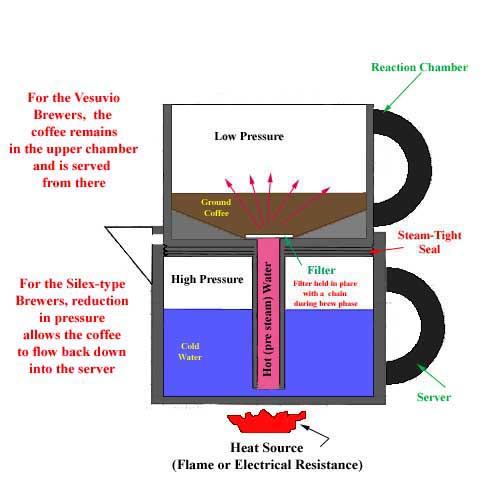
Schematic of the Vacuum Coffee Brewing Method
The vacuum brewer has three parts: a server, a reaction chamber, and a filter. Cold water is placed in the server (lower part) and ground coffee is placed in the reaction chamber (upper part); a filter separates the two parts. The server and reaction chamber are arranged so that there is a steam-tight seal between the two. The filter is designed so that hot water can pass through it, but the mesh size prevents coffee grounds from penetrating.
As the water is heated, the air trapped above the water also heats. As the air heats, it expands. Since there's nowhere for the air to go (because the neck of the upper unit extends below the water, the expansion of the air increases forces heated water to the upper chamber. (The reaction chamber is designed with a long narrow tube to ensure that it always below the water in the lower chamber. Because considerable pressure is exerted, the filter is held in place with a chain.) This continues until nearly all the water has been expelled from the lower chamber. At that time, the heated air (not steam) escapes from the lower chamber, equalizing pressure, and creating the characteristic burbling sound that tells you it's almost coffee time. The water remaining in the lower chamber continues to heat, but being heavier than the air, only a little of this water moves into the upper chamber, drawn by the escaping air. At this point, in the automatic machines, the water reaches the cutoff temperature which trips the switch and turns off the heat (or the user pulls the plug on the non-automatic ones, or takes the stovetop units off the stove).
At this point, the process reverses. In the absence of heat, the air in the lower unit cools rapidly. As the air cools, it contracts, creating a low-pressure area in the lower unit. The difference in air pressure between the ambient air on the upper unit and the low pressure area in the lower unit is sufficient to draw the infused water through the grounds and filter back into the lower unit. Due to the slight loss of volume as a small amount of the original water has escaped as steam, there is always a slight vacuum hiss as the last of the water is drawn through the grounds, and some air is drawn in as the pressure equalizes. (Thank you, Mark Marburg!)
Here is one of the earliest Silex vacuum brewers that we have seen, probably from the late 1920s. In the early days of Pyrex glass, it was difficult to make thin and delicate objects, because the same properties that made the glass heat-resistant made it brittle. Thus, early Pyrex brewers have these "ribs" for strength. These "ribbed" Silex brewers are also quite rare, because most of them broke...
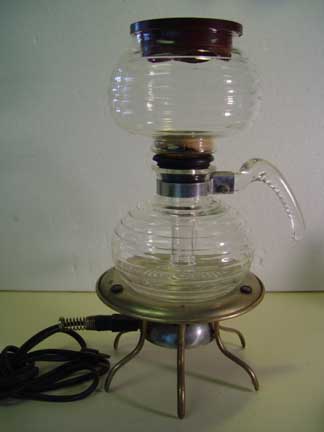
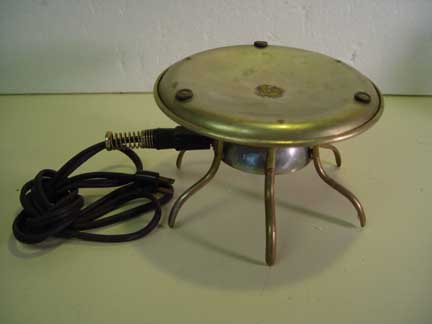
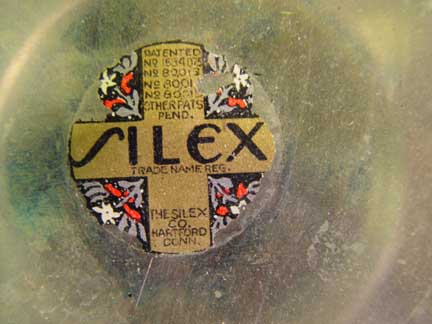
The 1920s "Ribbed" Silex Brewer
Our Very Grateful Thanks to Reader Greg For Sending This In!!!
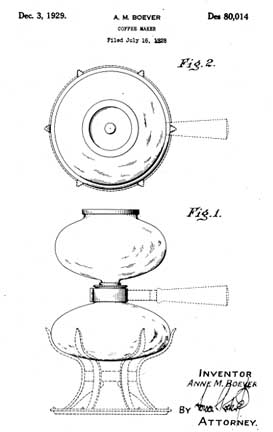
Anne Boever's Patent D-80,014 Patent for the Brewer
Click here if you want to learn how to get free Patent Drawings
Here are the Instructions for using a very early (1920s) Silex Vacuum Brewer:
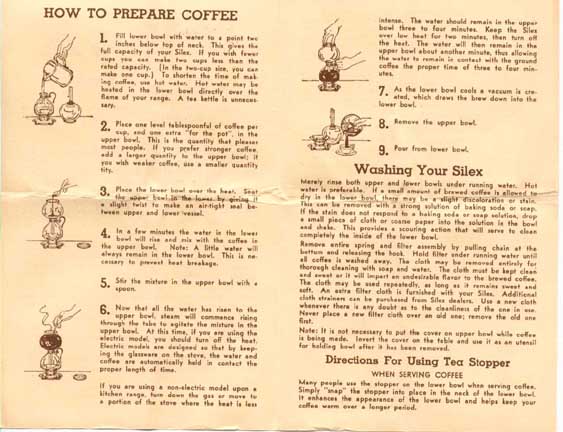
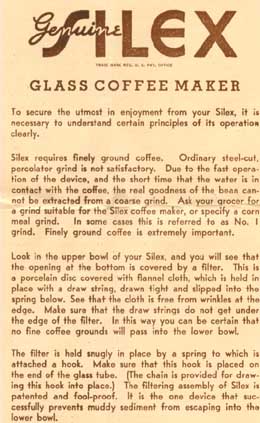
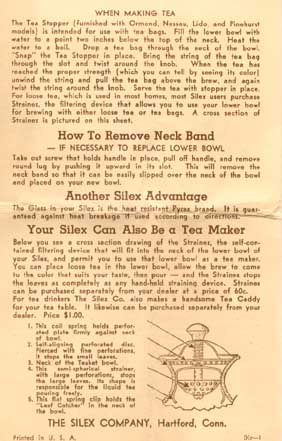
Directions for the Silex Vacuum Brewer (and the rare Tea-Making option)
Our Very Grateful Thanks to Reader Kim For Sending This In!!!
Below, you will find some pictures of a very early Silex coffee maker, including the server, reaction chamber, filter and an electric "stove" to supply heat.
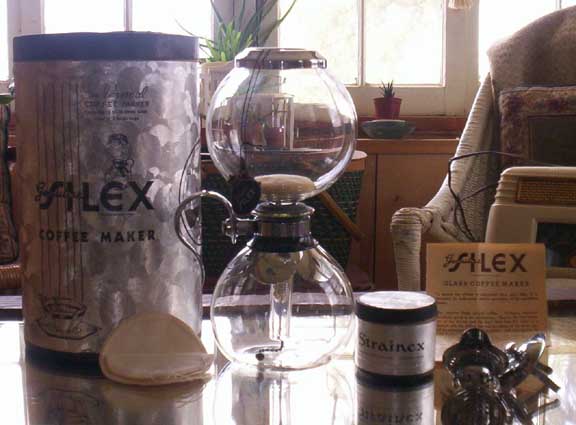
An Early 4-cup Silex Vacuum Brewer -- and its Original Box
Our Very Grateful Thanks to Reader Kim For Sending This In!!!
(more on this below..)
The "Strainex" filters allowed you to brew tea in the thing as well...
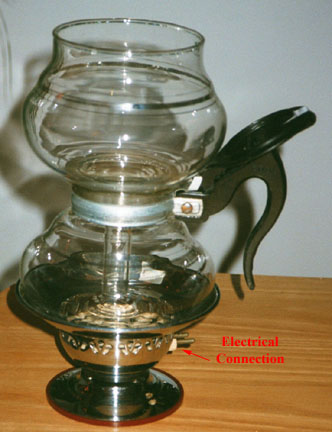
An Early 8-cup Silex Vacuum Brewer
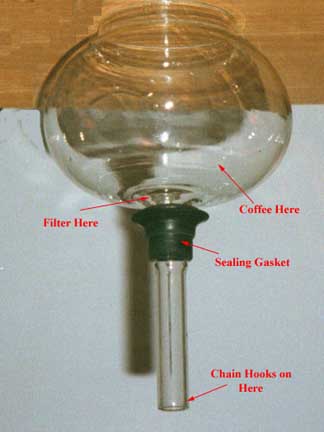
Silex Reaction Chamber
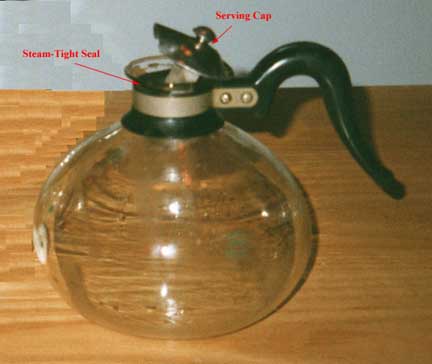
Silex Server
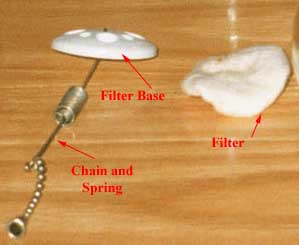
Silex Filter and Chain
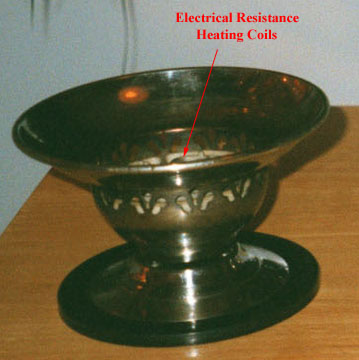
The "Stove" or Heating Element
The Silex-type brewers were very elegant. The very rare original box for Kim's Silex 4-Cup is a good case in point. The graphics are spectacular, and they appeal to a woman of culture in the Morning, in the Dorm, or in the Afternoon, as shown below. Note that the ladies are dressed in the height of fashion.
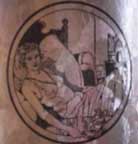
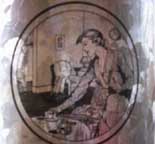
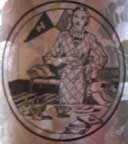
Coffee - 4 Large Cups or 10 Demitasse for the Lady of Leisure
Our Very Grateful Thanks to Reader Kim For Sending This In!!!
We have discussed "multifunctionality" as a concept in selling items that were quite expensive in our pages on Kitchen Mixers and Vacuum Cleaners. Briefly, folks in the Depression were more likely to spend money on an appliance if it did more than one thing. Here is multifunctionality applied to the Silex brewer -- there was a filter attachment called a "Strainex" that would allow you to brew tea in the device.
The Strainex is patented -- U.S. Patent 1,702,243 was granted to Frank deP Axtell of New York City on February 19, 1929 for a "... means to support a body normally submerged in a vessel and to permit the raising of said object out of the fluid contained within the vessel ..." In plain words, he made a gadget that would hold a teabag and let you yank it out without making a big mess...
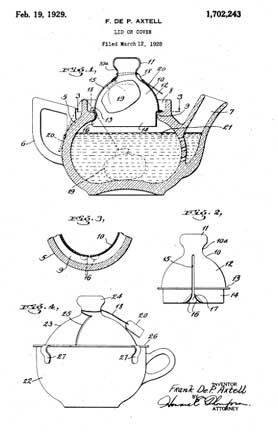
The Strainex Patent - No. 1,702,243 Granted February 19, 1929
Lowering and Raising a Body in a Vessel
Click here if you want to learn how to get free Patent Drawings
During the 1970s, Saturday Night Live did a sketch about an "Mr. Tea" brewer; this is the same thing -- the elaborate vacuum system is replaced with an attachment to hold tea leaves and the server is simply used to boil water. The gadget has a part that works like an old-fashioned tea infuser.
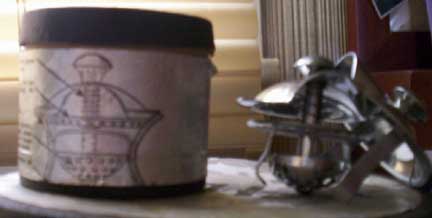
The Multifunctional Tea Maker
This is the first of these that I have ever seen!
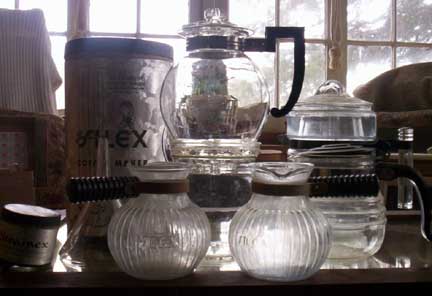
Here are some more Silex devices from Kim's collection
This is very good from a theoretical point of view, but the Silex presented certain operational difficulties. For example, you had to watch the thing like a hawk to remove it from the heat exactly when the water had boiled out, otherwise, you would wind up boiling the coffee that had flowed down into the server; conversely, if you took it off the burner too soon, then the brew would drain down into the remaining water and create a weak, diluted beverage. The steam seals would harden, making it difficult to separate the pieces. It is almost impossible to clean the long narrow neck of the reaction chamber. (The Fuller Brush Company used to sell a special long, thin brush just to clean vacuum coffee makers...). The filters were made of cheesecloth and had to be changed regularly. (the lady of the house was expected to sew new ones...) The stove could get very hot and, if left unattended could be a danger to children. Finally, the product can be misused -- people can put coffee in the lower part and water in the upper part leading to a disgusting mess and possibly an explosion. (This was used to comic effect in several films, particularly Woman of the Year with Katharine Hepburn and Spencer Tracy.) And, last but not least, these delicate hand-blown glass objects broke very easily.
Here are some photos of a vacuum machine from Germany that has all of the above problems. Note here that the reaction chamber is held to the server by a metal "clamp". Our reader Karen sent these photos with a question of how to clean the "gunk" that had accumulated in the narrow tube.
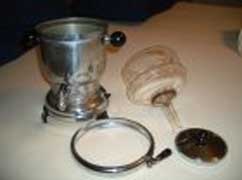
The German Vacuum Pot - Components
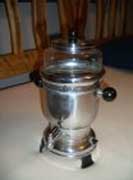
The German Vacuum Pot - Assembled
Our suggestion was to toss the reaction chamber into a big pot of warm water and add a handful of effervescent denture cleaning tablets. Our reader took us up on that:
"....we purchased the denture cleaning tablets last evening and tried them out on the pot, both top and bottom (used 4 tablets in the top, same for the bottom). I'd say it removed about 98% of the "gunk" from the glass top......it didn't do anything to the stain in the metal bottom. This was a very good experiment in my estimation and I am very pleased with the results...."
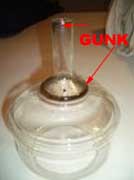
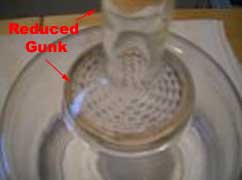
Removing Gunk with Denture Cleaning Tablets
However, relief was at hand thanks to the efforts of Inez H. Pierce of Chicago, Illinois. On August 27, 1930, she invented a device for automatically monitoring the vacuum brewing process. She was granted US Patent 1,994,323 on March 12, 1935 for her efforts. As shown below, she ipmroved the vacuum process by incorporating the stove into the server. She heated the water in a "well" which expedited the time to reach the boiling point and assured that pre-steam water would be directed into the reaction chamber. She also included a thermostat (based on metallic expansion) to shut off the heat at the appropriate time. Here are the patent Drawings for Ms. Perce's invention:
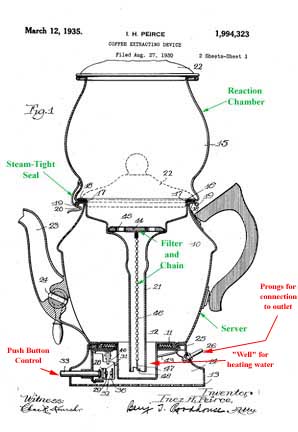
Components of Ms. Pierce's Design
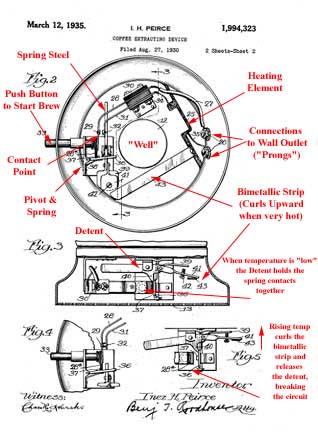
Design of the Thermostat
Click here if you want to learn how to get free Patent Drawings
Briefly, Ms. Pierce's invention relies on a "push button" to engage two spring-steel contacts. When the button is pushed in, a locking device (the "detent") holds the circuit closed and allows a heating element to get red hot. This is conveniently arranged in the "well" where the lower part of the reaction chamber is located. This conserves electricity in that it only heats the water in the place where it is going to rise into the reaction chamber. The bottom part of the server is shaped so that all the water in it will flow into the well. When all the water has been converted to steam, the temperature in the well will rise dramatically. At this point, a bimetallic strip will curl upward, trip the detent and break the circuit. Several adjustment screws are provide to control the timing of events. The bimetallic strip is made up of two metals with very different expansion properties (like copper and steel). If the one that expands rapidly is placed on the bottom, the strip will curl upwards as it is heated because the bottom part wants to expand faster than the top.
It should be noted that Ms. Pierce's drawings reflect the configuration of the Sunbeam C-20A. See below for more discussion on this point...
Ms. Pierce's invention is the first truly "automatic" vacuum coffee brewer, and is the basis in design for the Farber automatic "Coffee Robot."
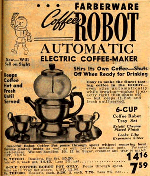
Original Ad for the Farber Coffee Robot
Here is a very lovely Farber Coffee Robot Model 511 with an accompanying Tray, Sugar and Creamer. The exterior was designed by Simon Farber of Brooklyn, New York. However, he relied heavily on both Ms. Pierce and John E. Smith (of Belleville, Illinois) for the "automatic" shut-off feature.
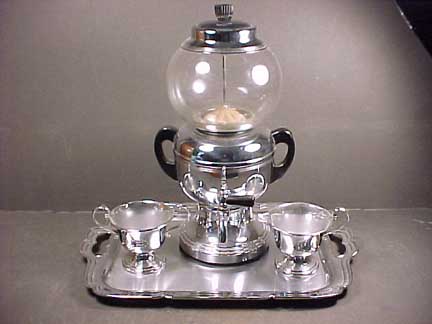
"Acme Ron" Owns this Mint Farber Model 511 Tray set
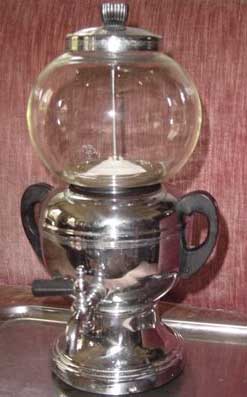
Our reader "Prudence" sent a photo of her Model 511
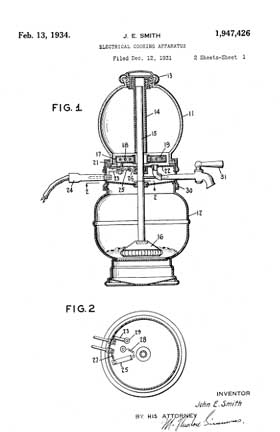
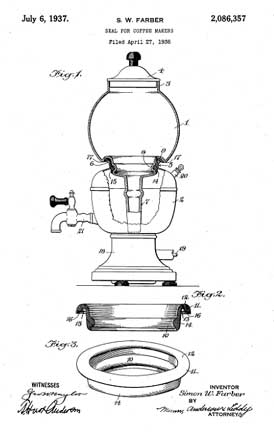
Smith and Farber's Mechanical Designs for the Coffee Robot
Click here if you want to learn how to get free Patent Drawings
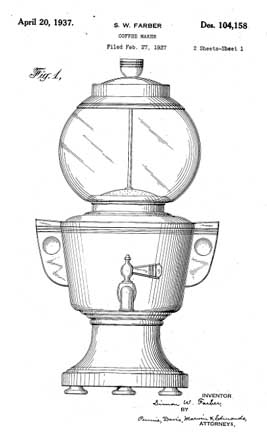
Simon Farber's Artistic design for the Coffee Robot
Click here if you want to learn how to get free Patent Drawings
We are indebted to "Acme Ron" for sending us this wonderful photo of a brand new "never-been-used" Farber Coffee Robot. Here is the original shipping tag!
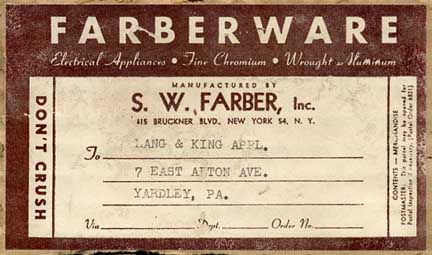
Original Shipping Label for the Coffee Robot
The Pierce design was a great improvement over the Silex design, but those nasty filters were still a problem. If the chain broke, there would be a mess as the filter would shoot toward the ceiling. Plus, housewives all over the country were getting sick and tired of sewing those cheesecloth covers. In addition, there was still the problem of the doofuses who put the coffe in the server instead of the reaction chamber. In that case, the coffee would swell and block the reaction chamber tube, which could lead to either an explosion or a very nasty cleanup mess. Fortunately, Ivar Jepson, Ludvig Koci, and Eric Bylund were on hand to solve these problems. They also improved the shape of the water heating zone, eliminating Pierce's "well" which had been hard to clean. (Mr. Koci is also famous for designing the astounding Sunbeam T-9 Toaster).
This dynamic trio was employed by the Chicago Flexible Shaft Company which all of you antique buffs now know as the parent company of Sunbeam. Jepson et al devised a completely new metallic filter that sent the cheesecloth filters back to Wisconsin. Their invention was filed on March 9, 1942 and Patent 2,345,264 was granted on March 28, 1944. They hired Alfonso Ianelli to design the exterior and the incredibly beautiful Sunbeam C-20, C30, C-40 and C-50 line was born.
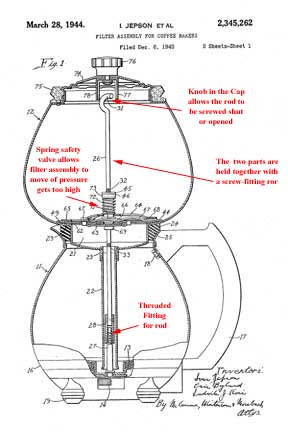
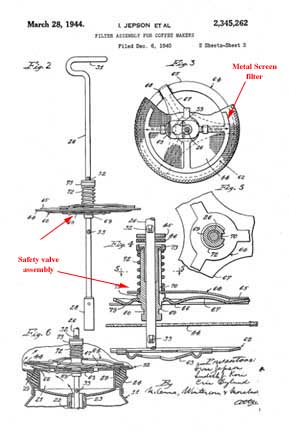
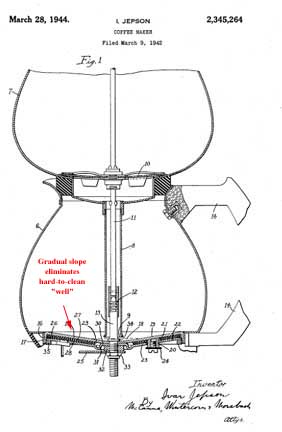
The Jepson improvements to vacuum Brewing
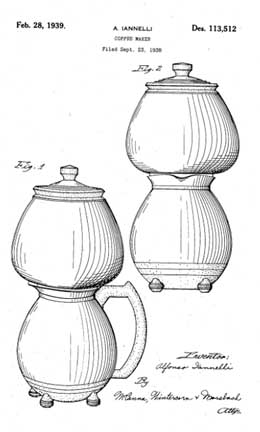
The Alfonso Ianelli's Stunning Exterior Design
Click here if you want to learn how to get free Patent Drawings
Since World War II was in full swing, Jepson et al. did not get to see their invention put into production for several years. However, when consumer goods returned to America, the Jepson patent led to the most beautiful vacuum brewer ever to be made -- the Sunbeam Coffemaster. This lovely device began as Model C-20 and went through several incarnations into the 1960s, culminating in the C50. The very early models have bulbous feet that morphed into a slender, cylindrical shape. Only the C-20 used the "screw down" method to secure the filter-rod assembly since it was a bit tricky to engage. The C-30 models improved this by using a filter-rod assembly that truncates in a hook at the bottom. In turn, the hook catches the bottom of the reaction chamber's "tube" or funnel. This hook-style rod was retained to the end-of-run C-50's.
Another "improvement" featured on the C-30's that C-20's did not have was the much needed handle (a match for the server) which allowed for better post-brew handling of the often scorchingly hot reaction chamber.
Check out our page on Coffee Paraphernalia for the actual directions for the C30.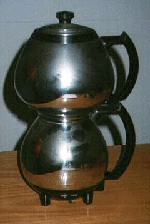
Sunbeam C30-A Vacuum Coffee Brewer
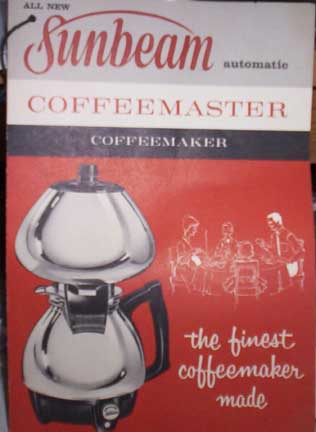
Instruction Booklet for the C50-A, the Ultimate Descendant of the C30
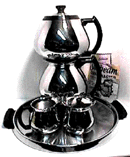
An attractive Tray Set for the C30-A
The C30A has a problem with the seal between the two parts. If yours is stuck (the pieces won't separate), click here for more advice.
Over the course of the years, the design of the C30A changed incrementally (in some, the filter screws on and off). I only have one manual (see below) for one particular variant. The basic principles of the C30 reamained constant through the years, so the manual can still be helpful. Our reader Mark Marburg sent in these observations on the vacuum brewers:"...I have fond memories of watching my mom making coffee at our family's cabin in the 1960s, using a stove top metal vacuum pot that probably dates to the '40s. Watching the water mysteriously appear in the top was always fascinating. When living in New York in the mid-90's, I found a functioning glass Silex and electrical base. It had the ceramic thingy that held the filter but I could never figure out how the filter worked. Eventually, I just substituted a plastic filter from a modern-day vacuum pot that was sold by Macy's (it may have been a Melitta), and it worked fine. It even made the trip back home to Seattle. Sadly, one day when putting it back together, I dinged the neck of the lower section with the tube, and the neck cracked, so I haven't used it since - but I can't bring myself to throw it out. My brother, knowing my fascination with vacuum pots, one Christmas gave me a Sunbeam automatic that he'd found in a thrift store, and I've used that for years and enjoy it...
We have some FREE DOWNLOADS
You should know that the C-30 is discussed on our Coffee Paraphernalia page. Next, you can download the following items:
- C30 Operation Manual
- C30 Repair Manual
- Sunbeam Patent 1,994,323 (C30 Prototype - 1935)
- Sunbeam Design Patent D-113,512 (Alfonso Iannelli Exterior Design of the C30 -1939)
- Sunbeam Patent 2,223,450 (Original C30 - 1940)
- Sunbeam Patent 2,345,262 (Filter Assembly - 1944)
- Sunbeam Patent 2,345,264 (Bottom recess well - 1944)
- Sunbeam Patent 2,345,265 (Filter Assembly - 1944)
- Sunbeam Patent 2,687,469 Thermostat (1954)
- Sunbeam Patent 2,729,159 (C50 -- 1956)
The Vesuvio or Macchinetta
The Italians have been making a variant of the Vacuum Method brewer for some years that is called the "Vesuvio" (after Mount Vesuvius...) or the "macchinetta" (little machine.) In the US these are sometimes known as "Stovetop Espresso Makers." The container is made of heavy aluminim and is structured to operate at much higher steam pressures than the typical vacuum machine -- it even includes a safety valve to prevent explosions. In this case, the coffee is actually brewed by steam under high pressure and thus it may be technically called "espresso" (although purists would disagree vehemently, see below). The Vesuvio-type devices work fairly well and are easier to clean and operate than the vacuum machines.
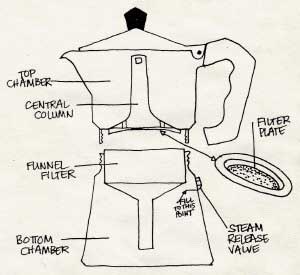
Schematic of the Vesuvio

Vesuvio Style Brewer
The Machinetta has a downward pointing funnel in the reservoir captured at the wide end by a doughnut shaped gasket containing a disk shaped screen. This is located at the bottom of the upper carafe unit. The narrow end of this lower funnel goes to within about 1/8" of an inch of the bottom of the reservoir ( like the Silex) and has a disk screen down a ½ " or so from the wide top to hold the coffee groundsand prevent the coffee grounds from entering the lower chamber. The coffee is wetted by the flow of hot water upward through that screen disk. That is accomplished by pressure of boiling water steam like percolators. During the brewing flow the grounds are stopped by the doughnut shaped gasket screen in the top carafe. The carafe has a built in inverted funnel with a cap over it and holes in the narrow part near the top. The coffee liquid then flows up through the funnel and into the upper carafe through those holes. When the brew is done, the coffee liquer cannot return to the lower reservoir because the upper end of the funnel is higher than the brew surface. No valve needed! The coffee may be poured without removing the reservoir.
Thank you, Richard!
The only thing that ever goes wrong with these devices is that the gasket between the lower and upper parts will begin to deteriorate and the thing will spew steam out the joint. This is easily fixed. Consult HREF="http://www.espressozone.com/stovetop-espresso-maker-parts.aspx?gclid=CNeW7bfsz6MCFRE95QodL1KrwQ">Theis Site for replacement parts.
Gail, one of our readers, supplied these photos of The STAR ("stella") is an unusual coffee maker ("caffettiera") that is basically of the Vesuvio type.
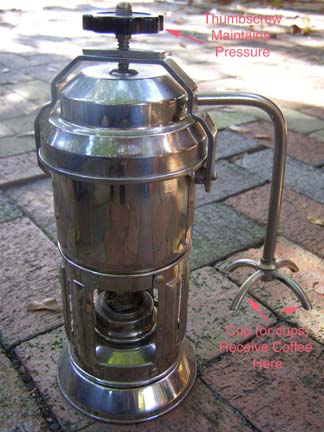
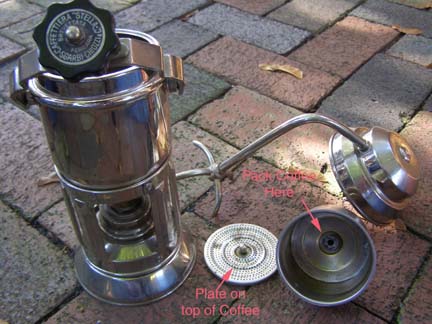
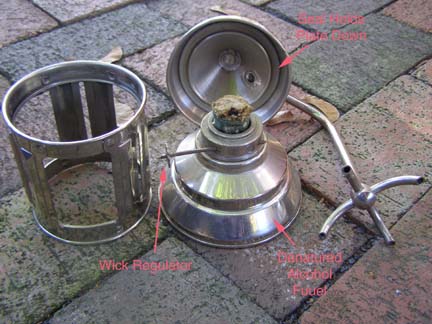
A Better Mousetrap, Italian Style!
Thanks to our Reader Gail
Click on any Photo to Enlarge it
The threaded knob holds the pressure vessel together. Coffee is packed tightly in the basket and water is placed in the bottom. The alcohol lamp heats the water and the resultant steam forces its way upward through the coffee, simultaneously exerting pressure on the brewed liquid to drive it out the four-pronged spout. My guess is that the spout just fits into a big mug or cup, or it could be used to fill four demitasse at once. I have annotated the photos to help you.
I have put this on the site as a curiosity. It seems like there are a million companies that make "Caffettiere" and each one adds some little modification to the basic design. This one looks like it was made from sheet stock and doesn't require casting or machining threads like the typical Vesuvio. Since it uses alcohol fuel, it would have been a great idea for places in Italy without regular electric or gas service. I'd say that it was designed in the 1920s, but could have been made any time up to the present.
Espresso
At this point, we enter a realm of technology that is sure to spark considerable debate. Espresso (or Expresso) refers to a method of making coffee that involves both Pressure and Steam. There is considerable debate about the amount of pressure and the role of the steam, but both are necessary. The principal difference between the other brews and espresso is that the water actually penetrates the coffee grains as opposed to just flowing around them.
The espresso brew is chemically much more complicated than "normal" coffee. It is simultaneously: (1) a solution of sugars, caffeine, acids, and proteins, (2) an emulsion of oils and colloids; and (3) a suspension of coffee particles and bubbles of carbon dioxide gas. Because of the high pressure of the extraction, about ten percent of the oils inside the coffee are emulsified and highly volatile compounds attach themselves to the fats, yielding the characteristic espresso fragrance. The oils are partly responsible for the body of the coffee. This oil-fat arrangement gives espresso a velvety feel when sipped. Also, the high viscosity of the lowers surface tension allowing deeper penetration into the taste buds, creating a singular taste perception. (The presence of tiny bubbles of gas in suspension and emulsified colloids, mostly carbon dioxide, has the property of inhibiting the receptors of bitter taste in the gustatory papillae.)
Apart from the very early inventions, espresso has never been brewed directly with steam. Steam pressure was used merely as the vehicle to pass the heated waterthrough the packed coffee at high pressure to extract the beverage. The finely ground coffee is packed in the portafilter and tremendous pressure (8-9 bars or 112-126 psi) is required to extract the oils etc. Steam pressure alone can't be used, since en espresso boiler can only be safely maintained at 1.2 bar (about 16 psi), so an external method of creating the pressure was needed. At the beginning of the 20th century, Luigi Bezzera invented the lever espresso machine, where a large spring, compressed by a lever could be used to create the force necessary to extract the coffee.

Schematic of the Espresso Process
Contemporary Pavoni Espresso Machine
Showing the general layout of parts
Bezzera was a poor man, and in 1905 sold the patent to Desiderio Pavoni, the first company to market the commercial spring lever espresso machine. The first espresso machine reached the USA in 1927 and was installed at Regio's Restaurant in NYC (it is still there and working...) The exertion needed to compress the spring by pulling the lever before releasing it to extract the shot, led to the term "pulling a shot" which is still common among baristas.
Original American Espresso Machine
Still Working at Regio's
The Gaggia company perfected espresso by cooling the steam as it contacted the heavy "group" (where the portafilter is inserted holding the ground coffee). The brewing water was kept at the correct (88-92 c /201 f) temperature required for the extraction.
The spring lever was the dominant commercial espresso technology until the pump machine was invented in the '50's by Faema. Faema also invented the legendary E51 head (group) that was heated by boiler water circulation to maintain ideal temperature for brewing. Pump machines were used to force the water through the coffee rather than the force of the lever. Many "home expresso" machines use pump technology.
The Famous Gaggia Espresso machine
Espresso Makers
Brass and Eagles have always been featured
The term "espresso" has two meanings in relationship to the process. First, it means that the single serving of coffee was made solely (espressly) for the cutomer, and secondly that the coffee was squeezed out (expressed) by high pressure. However, mixed in with this is the connotation of steam trains with special schedules (as in the "Wabash Express") So, Espresso is coffee brewed with steam and pressure, made one serving at a time. Toot! Toot!

Join Us on Facebook
Counter for the Entire Site (not just this page..)
Home | About Lindy | 1940s Collectibles | Upcoming Events | Vintage Clothing
The Guide - Establishments - Travel - Accessories
Music | Links | Photo Gallery | Extras | Contact